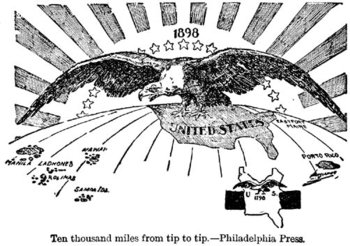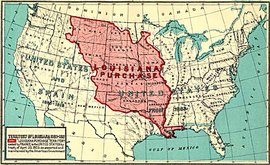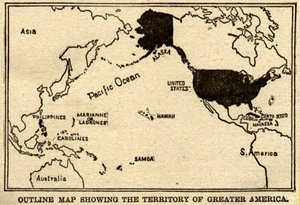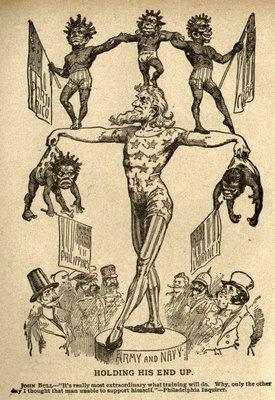History of United States imperialism
|
|
U.S. History Timeline & Topics |
| Colonial America |
| 1776–1789 |
| 1789–1849 |
| 1849–1865 |
| 1865–1918 |
| 1918–1945 |
| 1945–1964 |
| 1964–1980 |
| 1980–1988 |
| 1988–present |
| Diplomatic history |
| Imperial history |
| Military history |
| Industrial history |
| Economic history |
| Cultural history |
| edit box (https://academickids.com:443/encyclopedia/index.php?title=Template:USHBS&action=edit) |
At its start, the United States was a collection of small colonies on the eastern seaboard with little international import. What was to become the United States had existed for almost two centuries as part of the British Empire. The emergence of independent nations through the American Revolutionary War was a rejection of this colonial relationship. Over the next two centuries the United States first spread across the North American continent and then rose to become the world's most dominant power. Some argue that the means by which the United States expanded and asserted its authority were classic examples of imperialism—the United States was simply in a situation like that of Russia, where it had its empire touching its borders, unlike the European powers who could exapand their borders only at the expense of other European countries and otherwise had to go overseas. Such a definition of imperialism could, however, result in a great many countries being defined as "imperialist"—China, Russia, Canada, modern Japan, perhaps even Indonesia, and so on—since it would simply mean that a nation has expanded its territory in some way in the past.
| Contents |
Continental Expansion
See also Indian Wars
According to some of those who argue the U.S. has been imperialistic, the first step on the road to imperialism was the conquest of the Native American peoples who inhabited North America. This view began to be advocated in the 1960s and 1970s by such historians as William Appleman Williams. The American expansion westward had many similarities to European activities in Africa and the first arrivals of Europeans in the Americas. Others argue that there is a difference between expansionism and imperialism. They argue that the American expansion driven by settlers and a need for more land was very different from European imperialism that was primarily a search for raw materials and new markets, with colonization and settlement only an occasional side effect.
The Louisiana Territory
The Louisiana Purchase, the 1803 transaction of the gigantic western Louisiana Territory from France (Napoleon Bonaparte) to the United States (Thomas Jefferson), is often considered the first major event in American expansion, although it is rarely cited an act of imperialism. However, the Louisiana Government Bill that followed it, although less well-known, is often cited as an early instance of heavy-handedness and hypocrisy in the early United States.
After the Louisiana Purchase, Thomas Jefferson signed the Louisiana Government Bill, which denied the new United States territory the right to self-government. Instead, it was to be ruled by military officials under direct orders from the capitol. Since most of the population of the territory consisted of non-whites and Catholics, Jefferson felt that the government should suspend its right to self-government until enough white settlers moved west to command a majority. Modern-day critics of this choice point out the irony in the fact that Jefferson, who had decried British denial of American self rule in the Declaration of Independence, was now issuing the orders to deny self-rule in an American territory, issuing commands from half-way across the continent.
Some would argue that the actual owners of the bulk of land was neither France nor the United States but rather the Native Americans who had resided on it for centuries and who were not consulted about this transaction. Others would reply that this would be to apply a 20th-century viewpoint to 19th-century circumstances, and to assume a concept of ownership of land not actually held by Native Americans.
The Mexican American War
The Mexican-American War from 1846-1848 is often viewed as motivated by American imperialism. In 1846, President James K. Polk sent soldiers to the disputed zone between Mexico and the newly annexed Republic of Texas in what most historians describe as a provocation for war. After war broke out, American forces quickly defeated those of Mexico, and in the Treaty of Guadalupe Hidalgo, Mexico ceded its claims on what is now almost the entire Southwest and California to the United States, in exchange for $15 million and the settlement of pending individual claims against Mexico valued at about $3 million.
Many aspects of the war and its aftermath were controversial. A faction called the Continental Democrats had advocated annexing all of Mexico, some arguing that Mexico should be punished for its behavior. Others, largely in the North, denounced the war variously as imperialism and as a pro-slavery stratagem to add more slave territory to the United States.
Today, there is some question over the nature of the Mexican-American war. Most claim that it was aggressive in nature, prompted by Manifest Destiny. Among these, some historians claim that it was simply a grab for more territory, whereas others see it as part of a concerted expansionist movement, reminiscent of imperialism.
The Civil War
At the time of the United States Civil War many Southerners looked on the Union's action as imperialistic. Tracing their ideals back to the American Revolution, the Confederacy proclaimed that they had the right to self-government just as young America did in 1776. Some Southerners today still refer to the Civil War as the "War of Northern Aggression."
Age of Imperialism
See also History of the United States (1865-1918) and New Imperialism and the emerging empires.
The late nineteenth century is the era which most historians consider to be that of imperialism. Starting as early as the 1870s the United States began to aggressively expand its influence overseas. The annexation of Hawaii and the fall-out from the Spanish-American War saw the United States very closely adopt the European model of empire. The era also saw the first widespread protest against American imperialism. The population was divided between those that saw the economic and strategic benefits of colonies and those that felt it was counter to America's founding ideology. Noted Americans such as Mark Twain spoke out forcefully against these ventures. The same period saw other notables such as Rudyard Kipling advocate the idea of The White Man's Burden to "civilize" the rest of the world.
During this same period the American people continued to strongly chastise the European powers for their imperialism. The Boer War was especially unpopular in the United States and soured Anglo-American relations.
Causes

There are two major historical schools of thought as to this period of expansionism. Some historians, notably Samuel F. Bemis, concluded that the imperialism of the 1890s was "the great aberration", a very different form of territorial growth than that of earlier American history. Others, such as Walter LaFeber saw this expansionism not as an aberration but as a culmination of Western United States expansion. In any case, a variety of factors coincided during this period to bring about an accelerated pace of U.S. expansionism:
- The industry and agriculture of the United States had grown beyond its need for consumption. Powerful business and political figures such as James G. Blaine believed that foreign markets were essential to further economic growth, promoting a more aggressive foreign policy
- The prevalence of racism, notably Ernst Haeckel's "biogenic law," John Fiske's conception of Anglo-Saxon racial superiority, and Josiah Strong's call to "civilize and Christianize" - all manifestations of a growing Social Darwinism and racism in American thought
- The development of Frederick Jackson Turner's "Frontier Thesis," which stated that the American frontier was the wellsprings of its creativity and virility as a civilization. As the U.S. West was gradually becoming less of a frontier and more of a part of America, many believed that overseas expansion was vital to maintaining the American spirit
- The publication of Alfred T. Mahan's The Influence of Seapower on History in 1890, which advocated three factors crucial to The United States' solidarity as a world power: the construction of a canal in South America (later influencing the decision for the construction of the Panama Canal), expansion of the U.S. naval power, and the establishment of a trade/military post in the Pacific, so as to stimulate trade with China. This publication had a strong influence on the idea that a strong navy stimulated trade, and influenced policy makers such as Theodore Roosevelt and other proponents of a large navy.
Alaska
In 1867 president Andrew Johnson purchased the territory of Alaska from the Russian Empire for seven million dollars. It was the first acquired piece of American territory to not be a direct part of the continental United States, and was a hotly debated issue at the time being referred to derisively by some as "Johnson's polar bear garden".
Hawaii
The Kingdom of Hawaii was long an independent monarchy in the middle of the Pacific Ocean. During the nineteenth century first American missionaries and then American business interests began to play a major role in the island. Most notable were the powerful fruit companies, such as Dole Pineapple. After a coup financed and directed by American interests overthrew the isolationist Queen Liliuokalani, the island became a republic in 1894 and in 1898 Hawaiian President Sanford Dole agreed to his nation's annexation by the United States. The republic ended in 1900 and the country became a territory of the US.
The Spanish-American War
With the Spanish-American War the United States greatly increased its international power.
US opponents of the war, including Mark Twain and Andrew Carnegie, organised themselves into the American Anti-Imperialist League.
The Spanish-American War took place in 1898. The Treaty of Paris (1898), ended the Spanish-American war, giving the United States possession of the Philippines, Puerto Rico, Guam, and Cuba in exchange for $20 million.'
Conflict in the Philippines
The Philippine-American War (1899-1913) is another instance of United States imperialism. While many Filipinos were initially delighted to be rid of the Spanish rule of the Philippines, the guerrilla fighters soon found that the Americans were not prepared to grant them much more autonomy than Spain had. Thus for the next six years American forces engaged in a war in the jungles of the Philippines against the insurgents. The war was expensive and quite unpopular in the United States, but eventually victory was obtained.
Latin America
The early decades of the 20th century saw a great amount of interference in Latin America by the US government, often under the guise of the Roosevelt Corollary to the Monroe Doctrine, and most often openly in aid of US corporate interests. President William Howard Taft viewed "Dollar Diplomacy" as a way for American corporations to benefit while assisting in the national security goal of preventing European powers, above all Great Britain and Germany, from filling any possible financial or power vacuum. Many argue, however, that this situation amounted to the United States having a de facto empire in the Americas throughout this period.
- 1901: Platt Amendment effectively renders Cuba a protectorate of the United States, putting severe restrictions on the Cuban government's financial freedom, granting the US its base at Guantanamo Bay, and reserving the right of the US to intervene in Cuban affairs. Cuba is also pressured to write the provisions of the Platt Amendment into its constitution.
- 1903: US customs receivership in Haiti following collapse of Haitian government and threats by France and Italy to intervene to collect their debts.
- 1903: US backed independence of Panama from Colombia in order to build the Panama Canal; Hay-Bunau Varilla Treaty
- 1904: Theodore Roosevelt announces his "Corollary" to the Monroe Doctrine, stating that the United States would intervene to protect Washington's interests in the Western Hemisphere should Latin American governments prove incapable or unstable.
- 1909: forced resignation of President Josť Santos Zelaya after triumph of US-backed rebels in Nicaragua
- 1912-1933: US occupation of Nicaragua
- 1914-1916: Mexico conflict, including US troops occupying north of the country and port city of Veracruz
- 1915-1934: US occupation of Haiti
Asia
While American intervention had begun earlier with Matthew Perry forcibly opening Japan to the West with the Convention of Kanagawa in 1854, this period saw the United States expand its presence in Asia. The US pushed through the Open Door Policy that guaranteed its economic access to China. It also vigorously acquired small islands in the Pacific, mostly to be used as coaling stations.
The Boxer Rebellion
Not long before the turn of the century, China was divided into what some call "spheres of influence" - areas to which a European nation (some involved were Austria, France, Germany, Great Britain, Italy, Japan, and Russia) had claimed exclusive trading rights, or even the territory itself. The United States, having recently captured the Philippines and thereby becoming a power in the Asia, was eager to reap its own benefits from China, but felt impeded by these "spheres of influence".
In an effort to eliminate this hindrance, John Hay, secretary of state at the time (under William McKinley), sent letters to European leaders suggesting an "open door" policy in China, one that would grant equivalent trading rights to all powers inside the spheres of influence. The proposal was gently rejected, but Hay, refusing to admit defeat, claimed otherwise, and called their agreement "final and definitive".
The Chinese, meanwhile, were thoroughly fed up with the exercise of Western power over their nation. The Empress Dowager, Tsu Hsi, sent a message to all China's provinces encouraging aggressive and forceful action against the "various powers". This message, in combination with increasingly difficult living conditions throughout China, drove many Chinese to join such organizations as the Fists of Righteous Harmony.
Members of the Fists of Righteous Harmony practiced martial arts (hence the name "Boxers", given by the foreigners) and held a number of fanatically religious and nationalist ideas, believing that they were immune to enemy bullets and would awaken spirit soldiers through their actions. Though originally created with the intention of destroying the current government as well as expelling the foreigners, Tsu Hsi began supporting the organization, and their goal gradually changed solely to the removal of the foreigners.
The first few months of the dawn of the 20th century, the Boxers rampaged throughout the Chinese countryside, destroying everything Western, such as Christian churches and those who associated with them. Tsu Hsi allowed the Boxers to enter the capital city of Beijing, despite having promised the foreign diplomats that she would crush the rebellion. The Boxers moved towards the compound housing the foreign diplomats just outside the Forbidden City. The diplomats threw up hastily-constructed defenses and prepared for the assault with a small armed force, but after approximately two months of repeated assault by perhaps 20,000 Boxers, they were short on supplies and men (76 defenders had been killed).
Before dawn, just short of two months from the beginning of the attack, the defenders were met with a pleasant surprise - the Western Powers, growing worried from the lack of communication with the diplomats, collectively sent an armed force to save the diplomats, including 2,500 American soldiers. These international forces ransacked the city, even the Forbidden Palace, thus destroying the power of the current Ch'ing dynasty (though the empress disguised herself as a peasant and successfully escaped).
Following the rebellion, the Hay called for an expanded "open door" policy effective throughout China, not just within "spheres of influence". The United States and the European powers also agreed to preserve Chinese independence and government, but continued to exploit the country for monetary gain until World War II.
After World War II
After helping defeat Nazi Germany, the United States occupied the Western sector of Germany (West Germany) for ten years, 1945 to 1955. More intense was the occupation of Japan from 1945 to 1951, during which time the US occupation force, led by General Douglas MacArthur staged a dramatic restructuring of Japanese society in order to prevent the nation from re-emerging as a military threat.
As with most aspects of American imperialism these more recent events are still disputed (especially in the United States itself) as many believe that they were not imperialist in nature. Many of the post war actions were implemented as the result of Cold War policy and anti-Communism feelings, which were the basis of much of the United States foreign policy. During this period the United States actively intervened in the politics of many nations, usually on the stated grounds to prevent the expansion of the influences of the Soviet Union, which quite openly employed imperialistic policies.
Some critics alleged that the United States' adversary to the Soviet Union and anti-Communist paranoia was causing the American government to become needlessly imperialistic, and was either propping up or overthrowing foreign regimes on often questionable grounds or suspicions. Other critics, especially those on the far left went even farther, alleging that the threat of Communist / Soviet expansion was a largely non-existent, and that the United States was simply meddling in the affairs of other states for more openly imperialistic purposes, such as gaining control of resources, land, or military bases.
This left wing thought became prominent in the 1960s and 1970s, mostly as a result of the backlash against the Vietnam War. Leading advocates of this new anti-imperialism included Noam Chomsky, Chalmers Johnson, and Tariq Ali.
The most notable aspects of this period tend to be American military interventions in areas such as Vietnam, Grenada, and Iraq. Many would argue, however, that cultural and economic imperialism had far greater effects.
Europe
During the 1960s and 1970s it became fashionable to view the Soviet empire in eastern Europe as comparable to the American domination of western Europe. It was argued that through economic and military pressure the United States pursued hegemony just as aggressively as the Soviet Union. The post-revisionist school, which since the fall of the USSR has come to dominate the study of Cold War history, has rejected this view. They argue that the full extent of Soviet aggression has become apparent after the opening of their archives. See historiography of the Cold War for more.
The Third World
During the Cold War the United States maintained an active presence in many third-world nations, especially in the form of spy groups and intelligence-gathering agencies. These groups often earned a reputation for active meddling in a country's government, and in some cases were blamed for orchestrating coups or assassinations that occurred.
The number of times that the U.S. has intervened in foreign nations since 1945 is too great to be included in this article. For a full list, see List of U.S. foreign interventions since 1945. Many of these interventions have been denounced by some as imperialist.
Cultural imperialism
Since the end of the Second World War the United States has been dominant in most of the cultural industries, and has often been accused of cultural imperialism. American movies, television, food, and music are popular throughout the world. Many argue that these serve to inculcate populations with American values while at the same time destroying indigenous cultures. This is often of greatest concern in other developed nations such as France and Canada. There is no consensus as to whether American cultural imperialism is intentional on the part of the States. The lack of government investment in American culture makes the spread of American movies, food and so on, more of a side-effect of capitalism than of Americanism per se.
Late 20th century
While for most of the United States' history imperialism has been a term used by critics to decry American policies, in recent years some have adopted the view that some forms of imperialism are desirable. Michael Ignatieff argues that American interventions should enforce intrinsic notions of human rights, and should have a form of "Empire Light" to do so. On the right-wing there are now thinkers who believe the United States should aggressively pursue a sort of democratic imperialism, these include Paul Wolfowitz and William Kristol.
See also
Ideas
- American Exceptionalism
- Black Legend (in relation to the Spanish-American War)
- Fifty-Four Forty or Fight
- Manifest Destiny
- Pax Americana
- Spread-eagleism
- American Empire
- Project for the New American Century
Key figures
- General George Armstrong Custer
- Geronimo
- President Andrew Jackson
- President William McKinley
- President James K. Polk
- Chief Sitting Bull
- President Theodore Roosevelt
- Colonel Zachary Taylor
- William Walker
- President Ronald Reagan
Historians
Views on the concept of United State imperialism have often been influenced by the opinions of the well-known historians of that period, who, in turn, are often influenced by the cultural and social attitude of their eras. Historians known for their views on the topic include:
- Tariq Ali, author of Clash of the Fundamentalisms (2002)
- Niall Ferguson, author of Colossus: the Price of America's Empire (2004)
- Walter LaFeber
- Goldwin Smith, author of Commonwealth or Empire? (1902)
- Howard Zinn
Related articles
- History of the United States
- US colonization outside North America
- United Fruit Company
- History of the United States (1865-1918)
External links
- "Imperial Amnesia" (http://www.foreignpolicy.com/story/cms.php?story_id=2582&page=0) by John B. Judis in Foreign Policy



